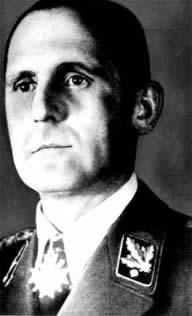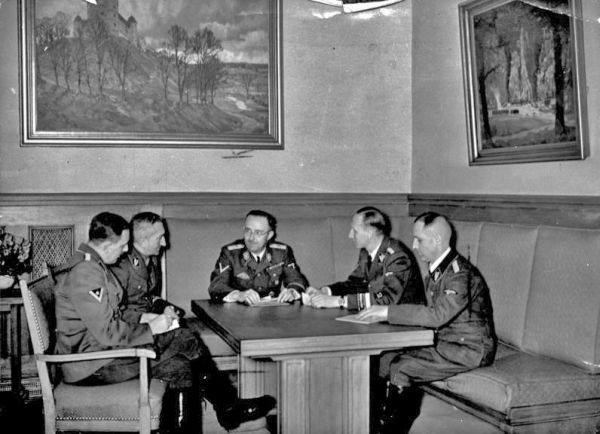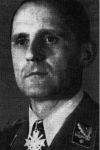Heinrich Müller
From pilot to policeman
Heinrich Müller was born April 28, 1900, the son of poor Catholic parents. After having finished school he took up a three-year vocational training as an aircraft mechanic. Before he enrolled in the German army at the age of 17, he worked in a Bavarian aircraft factory for a while. During World War One he served in the German Imperial army as a pilot. In recognition of his achievements in wartime, he was awarded the EK I and II (Eisernes Kreuz or Iron Cross). He left the army in 1919 after the defeat of Germany.
In December 1919, Müller found employment at the head office of the police in Munich. In 1929 he was appointed Polizeisekretär and in 1933 Kriminalinspektor. He spent a large part of his police career gathering information on the German Communist Party (KPD). Müller was known to be an anti-Communist and in the course of his work he seemed to have overstepped the law frequently. Ignoring the law would be no problem at all in the future. From the moment Hitler (Bio Hitler) took power all sorts of measures were introduced seeing to it that police and security officials were not bound during their work to any law meant to protect arrested persons.
The switch to the Nazis
During the period of the Weimar Republik, Müller was not allowed to be a member of the N.S.D.A.P. or a similar organization owing to his work for the police. In contrast to many of his later colleagues, Müller was not a fanatic Nazi and in addition, he did not belong to any political or ideological organization. Being an anti-Communist, Müller would not have had any objection against the new cabinet headed by Hitler that was formed on January 30, 1933. He continued his work in the Munich police office and when Reinhard Heydrich (Bio Heydrich) was appointed chief of the Bavarian police that same year, Müller became one of his closest associates.
Müller soon became known among the Nazis for his professionalism as a police officer and his fanatic devotion to duty and discipline were also noticed by Heinrich Himmler (Bio Himmler). In 1935 Müller was appointed supervisor of the Kriminalpolizei. Meanwhile, Müller had joined the ranks of the SS in April 1934 as SS-Untersturmführer and on June 4, 1934 he was promoted to SS-Obersturmführer. He was also given a position in the Sicherheitsdienst (SD), the intelligence service of the SS. The foundation of a brilliant career in the Third Reich had been laid.
When Himmler appointed Heydrich chief of the Gestapo in April 1934, he appointed Müller head of Section II. This department was responsible for tracking down possible enemies of the Third Reich including Jews. Within the SS he was promoted to SS-Standartenführer on January 30, 1937 and in June he was named management advisor of the Kriminalpolizei in addition to his function of department head in the Gestapo. Within the police, Müller occupied an increasingly important function. In 1938, Müller was involved in an important event in history for the first time, the Reichskristallnacht.
Reichskristallnacht
This Kristallnacht, so named after the many broken windows, took place in the night of November 9 and the morning of the 10th. German citizens, fanatic N.S.D.A.P. and SA members spread terror among the Jewish population all over Germany by setting fire to synagogues, destroying Jewish shops and maltreating Jews. This event was initiated by Reichspropagandaminister Joseph Goebbels (Bio Goebbels). The immediate cause was the murder of a German diplomat in Paris by a Jewish refugee named Herschel Grinspan and according to Goebbels, this was the right moment to teach the Jews a lesson. In order to prevent the situation from getting out of hand, the German police was tasked with keeping the pogrom on the right track. It should be prevented for instance Jewish shops would be plundered in the course of the pogrom as the goods in the destroyed shops were to be confiscated by the German authorities.
On November 9, 1938, from Gestapo HQ on Prinz Albrechtstraße 8 in Berlin, Heinrich Müller sent an urgent and secret message by telex to all police stations in the Third Reich. The message read: "Before long, actions against Jews and in particular against synagogues will take place all over the Reich. These actions must not be thwarted but contact must be made with the Ordnungspolizei (regular police), in order to prevent plundering and excesses." He continued: "Preparations must be made for the arrest of between 20 and 30 thousand Jews in the entire Reich. In particular rich persons are to be arrested. Detailed instructions will follow in the course of the night." These additional instructions originated from Heydrich and were sent by telex to all Gestapo and SD offices at 01:20. Heydrich’s orders confirmed Müller’s message but Heydrich was a little more specific. Receipt of Heydrich’s message was to be reported to Müller. Despite the efforts of Heydrich and Müller to keep the situation in hand, the Reichskristallnacht turned into an unorganized chaos. The SA had not understood the message and 7,500 shops, 29 department stores and 171 houses were destroyed; 191 synagogues had completely burned down and 76 more were severely damaged some other way; 11 Jewish community centers, death chapels and similar buildings were set on fire and three were looted. Partly on orders by Müller, at least 30,000 Jewish males were arrested and imprisoned in concentration camps.
Gleiwitz
September 1, 1939 the German army marched into Poland and this triggered World War Two. Hitler however wanted to make the outside world believe his invasion of Poland was an act of self defense and he ordered a few "Polish" attacks to be set up which were to be carried out on August 31. This deceptive action was largely organized by Heydrich, being the chief of the SD but Müller was also given a special role.
The first enacted incident was a "Polish attack" on a radio station near Gleiwitz on the Polish-German border. German SD men, dressed as Poles were to attack the radio station and transmit a message in Polish that the war between Germany and Poland had begun. The second incident was an "attack" on the German customs office at Hochlinden. A group of Polish speaking Germans dressed in Polish uniforms and armed with Polish weapons, were to raid the customs office and subsequently engage in a phony fight against SS troops. In order to convince the foreign press and provide material for German propaganda, Heydrich needed hard evidence and in that respect, Müller could be useful to him.
The hard evidence consisted of the remains of the so-called Polish attackers. Müller delivered a dozen convicted prisoners from concentration camps who were given a lethal injection and subsequently left behind at the locations of the phony attacks. To make it more convincing, the corpses were dressed in Polish uniforms and they even carried Polish military identity papers. At the end of the operations, the press was invited so they could be witness to the "Polish attacks" (See: Statement Naujocks). At the end, Heydrich was very proud of his own plan and his superiors also appreciated his talents of organization. When on September 27 the Reichssicherheitshauptamt (Main Office of State Security) was established, he was named head of this organization. An important role in the RSHA had also been reserved for Müller.
Amt IV of the RSHA
The Reichssicherheitshauptamt or RSHA was the umbrella organization of all police and security services in Nazi Germany. Within he RSHA Müller was given the function of chief of Amt IV, in other words the Gestapo (Geheime Staatspolizei or secret state police). In addition to this function he was also deputy commander of the Sicherheitspolizei (Security police or SIPO) and the Sicherheitsdienst (Security service or SD). Being chief of the Gestapo made him the superior of Adolf Eichmann (Bio Eichmann) and behind the scenes, Müller was involved in the organization of the Holocaust.
On January 24, 1939, Hermann Göring (responsible for supervision and coordination of the entire anti-Jewish policy) ordered Heydrich to set up the Zentralstelle für Jüdische Auswanderung (Central Jewish Emigration Office); Heinrich Müller was put in charge of this agency and he went about his task with fanatical drive. Müller saw to it that representatives of Jewish families submitted a list every day of 70 Jewish families who had to prepare for emigration. Towards the end of 1939 78,000 German and Austrian Jews as well as 38,000 Czech Jews would have left the Third Reich in this way. This compulsory emigration however did not offer the desired solution for this problem and eventually, many European Jews would be exterminated in the gas chambers of Auschwitz-Birkenau, Sobibor, Majdanek and other camps. Before it would come to that however, so-called Einsatzgruppen (special action squads) were established first. These were mobile death squads which were to kill Jews in the Soviet Union behind the advancing German troops.
Meanwhile, on December 16, 1940, Müller was appointed Generalmajor der Polizei and on November 29, 1941 he was promoted to SS-Gruppenführer und Generalleutnant der Polizei. In April 1941, Müller attended a conference with Heydrich in which the formation of the Einsatzgruppen was the central theme. Heydrich spoke about "a harsh task" which entailed "guaranteeing peace and quiet in the occupied areas in Russia." These words hid the actual task of the Einsatzgruppen but all those present understood Heydrich meant killing Jews. Only one man offered his cooperation voluntarily and that was Heinrich Müller.
Again, Müller played his role mainly behind the scenes within the organizational structure of the Einsatzgruppen. He forwarded Heydrich’s orders to the commanders of the four Einsatzgruppen. This way he gave the commanders a secret order on August 1 to report all activities of their units in the East. This way, Hitler could be kept abreast of their progress. Despite the fact that the activities of the Einsatzgruppen were secret, it was intended to keep track of all their crimes. In 1942, Müller ordered all traces of the mass murders by the mobile death squads in the East to be destroyed (Aktion 1005). At the Wannsee Conference, the Nazis had agreed on a "final solution of the Jewish problem". The Einsatzgruppen proved to be less efficient and from that moment on the extermination of European Jewry was taken on in an assembly line fashion.
During the Wannsee Conference of January 20, 1942, Müller represented the Gestapo. At that meeting, the organization of the extermination of Jews in the concentration camps was discussed. After the meeting, when most of those invited had left in the meantime, Müller, Heydrich and Eichmann had a cozy chat. While they had just been drafting plans to completely eradicate European Jewry, a relaxed atmosphere emerged at the fireplace while they enjoyed a glass of brandy. The three desk assassins seemed not to be bothered at all by the gruesome plans they had just been drafting. The three of them, together with their boss Himmler, were the major organizers of the Holocaust.
On May 27, 1942, Czech resistance fighters made an attempt on Heydrich’s life in Prague. June 4, he succumbed to his injuries. Heinrich Himmler deputized for him temporarily as chief of the RSHA but a suitable successor had to be found. Müller could well have been a very suitable and logical successor but he was bypassed nonetheless. On January 31, 1943, Ernst Kaltenbrunner (Bio Kaltenbrunner) was named the new chief of the RSHA. Prior to this new appointment, he had been State secretary of public security in Austria and in this capacity he supervised the Zentralstelle für Jüdische Auswanderung headed by Eichmann. Kaltenbrunner remained in charge of the RSHA until May 8, 1945. Müller was probably bypassed for this post as otherwise he would, in Himmler’s opinion, gain too much personal power.
Subordinate to Kaltenbrunner, Müller continued his work as chief of the Gestapo. In the last two years of the Third Reich, Müller remained directly involved in the Holocaust but he was responsible for other war crimes as well. In March 1944, Müller signed the so-called Kugelbefehl (bullet order), giving permission to execute escaped prisoners-of-war. In the summer of 1944, Müller was also involved in the arrest and execution of the conspirators who were involved in the July plot (the failed attempt on Hitler’s life by Claus Schenk Graf von Stauffenberg (Bio Von Stauffenberg). Some of his personal friends belonged to this group of plotters but their friendship did not stop Müller from having them executed. In recognition of his contribution to the arrest of the conspirators, he was awarded the Ritterkreuz des Kriegsverdienstkreuzes mit Schwertern (Knight’s Cross of the War Service Cross with Swords) a high German decoration for courage which was awarded to 211 men during World War Two.
Müller was loyal to his Führer until the very last day of Hitler’s life. The last location where Müller was seen was the Führerbunker, one day after Hitler’s suicide. From that moment on, it is unclear what has happened to Müller. There are rumors he had gone into hiding in Altaussee in Austria, using the alias Leutnant Schmidt and that subsequently he had been imprisoned in various American detention camps. Probably Müller has worked for the American Secret Service, the CIA as well. Reliable sources showing what happened to Müller after the war are non-existent and consequently facts about the post war life of Müller are unknown. One thing is certain though: Müller, who has had a major influence on the terror of the Nazi police machinery and the organization of the Holocaust, has never been brought to trial for his crimes. In addition the person of Müller has more or less faded into the background in the history books. Possibly because Müller mainly worked in the background, recorded history has paid more attention to the people who came to the fore with their work. In particular Heinrich Himmler, Reinhard Heydrich and Adolf Eichmann are universally known as Hitler’s henchmen. Müller however must not be omitted from this notorious company. He frequently cooperated closely with Heydrich, he was Eichmann’s boss and in addition, in his capacity as head of the Gestapo he was responsible for the terror this organization unleashed in Nazi Germany and occupied Europe.
Demise
On October 31, 2013, the German paper Bild reported it had information at its disposal to the effect that Müller had died in the final phase of the war and was buried in a mass grave in the Jewish cemetery in Berlin-Mitte. The paper quotes Johannes Tuchel of the Gedenkstätte Deutscher Widerstand (Memorial site of German resistance): "His body was laid to rest in a mass grave on the Jewish cemetery in Berlin-Mitte in 1945" unquote. He says he relies on archives.
Definitielijst
- Aktion 1005
- German secret operation to cover up the traces of mass extermination in the east. The bodies of the victims of the Einsatzgruppen and extermination camps were dug up from the mass graves and then burned. The operation was under command of SS-Standartenführer Paul Blobel.
- Auschwitz-Birkenau
- The largest German concentration camp, located in Poland. Liberated on 26 January 1945. An estimated 1,1 million people, mainly Jews, perished here mainly in the gas chambers.
- Einsatzgruppen
- "Taskforces of Deployment Squads". Special units composed of various SS and police services under supervision of the Reichssicherheitshauptamt (RSHA). Einsatzgruppen were deployed during the invasion of Poland in 1939 and during operation Barbarossa in 1941. In 1939 these units were ordered to eliminate the Polish intelligentsia. In the Soviet Union they were deployed to execute various political and racial enemies of the Third Reich, like Jews, gypsies and communists. The "Holocaust by bullets" in the Soviet Union was the horrendous first act of the eventual "final solution".
- Eisernes Kreuz
- Iron Cross. German military decoration.
- Führer
- German word for leader. During his reign of power Adolf Hitler was Führer of Nazi Germany.
- Gestapo
- “Geheime Staatspolizei”. Secret state police, the secret police in the Third Reich.
- Holocaust
- Term for the destruction of European Jewry by the Nazis. Holokauston is the Greek term for a completely burnt sacrifice.
- invasion
- Armed incursion.
- Iron Cross
- English translation of the German decoration Eisernes Kreuz.
- Jews
- Middle Eastern people with own religion that lived in Palestine. They distinguished themselves by their strong monotheism and the strict observance of the Law and tradition. During World War 2 the Jewish people were ruthlessly persecuted and annihilated by the German Nazis. . An estimated 6,000,000 Jews were exterminated.
- Nazi
- Abbreviation of a national socialist.
- propaganda
- Often misleading information used to gain support among supporters or to gain support. Often used to accomplish ideas and political goals.
- raid
- Fast military raid in enemy territory
- resistance
- Resistance against the enemy. Often also with armed resources.
- RSHA
- Reichssicherheitshauptamt. The central information and security service of the Third Reich.
- Sicherheitsdienst (SD)
- The national socialistic intelligence and counterespionage service of the SS.
- SIPO
- ”Sicherheitspolizei”. Combination (since 1936) of the Gestapo and criminal police.
- Soviet Union
- Soviet Russia, alternative name for the USSR.
- Wannsee Conference
- Conference at the Wannsee on 20 January 1942. The Nazi’s made final agreements about the extermination of Jews in Europe, the Final Solution (Ëndlösung).
- war crimes
- Crimes committed in wartime. Often concerning crimes committed by soldiers against civilians.
Images
Information
- Article by:
- Kevin Prenger
- Translated by:
- Arnold Palthe
- Published on:
- 19-04-2018
- Last edit on:
- 15-03-2024
- Feedback?
- Send it!
Sources
- KERSHAW, I., Hitler - Hoogmoed 1889-1936, Het Spectrum, Utrecht, 2003.
- KERSHAW, I., Hitler - Vergelding 1936-1945, Het Spectrum, Utrecht, 2003.
- KNOPP, G., Hitlers moordenaars, Het Spectrum, Utrecht, 2004.
- OVERY, R., De verhoren, De Bezige Bij, Amsterdam, 2002.
- READ, A., Discipelen van de duivel, Balans, Amsterdam, 2004.












